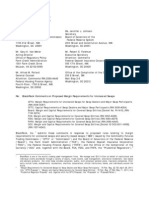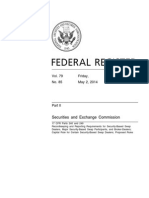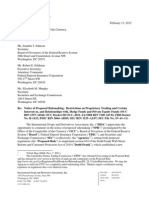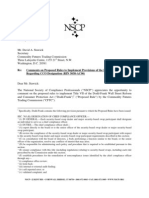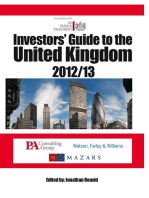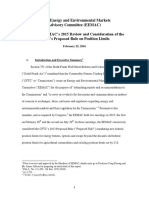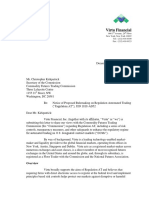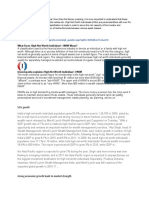Professional Documents
Culture Documents
Rio Tinto Pic Eastbourne Terrace London W2 6Lg United Kingdom
Rio Tinto Pic Eastbourne Terrace London W2 6Lg United Kingdom
Uploaded by
MarketsWikiOriginal Description:
Original Title
Copyright
Available Formats
Share this document
Did you find this document useful?
Is this content inappropriate?
Report this DocumentCopyright:
Available Formats
Rio Tinto Pic Eastbourne Terrace London W2 6Lg United Kingdom
Rio Tinto Pic Eastbourne Terrace London W2 6Lg United Kingdom
Uploaded by
MarketsWikiCopyright:
Available Formats
a
o
=
a
o
Rio Tinto pIc
2 Eastbourne Terrace
London W2 6LG
United Kingdom
T +44 (0) 20 77812000
F +44 (0) 2077811800
Ms. Mary L. Schapiro, Chairperson
clo Elizabeth M. Murphy, Secretary
Securities and Exchange Commission
100 F. Street, NE.
Washington, DC 20549-1090
RE: Dodd-Frank Wall Street Reform Act, Section 1503(a) and (b)
Release Nos. 33-9164; 34-63548; File No. S7-41-10.
VIA E-Mail: rule-comments@sec.gov
RE: File No. S7-41-10 March 1,2011
Dear Madam Chairperson:
These comments are being submitted to the Securities and Exchange
Commission (the "Commission"), in connection with the Request for Comments to
the proposed amendments to the Commission's rules in 17 CFR Parts 229, 239 and
249, relating to the Dodd-Frank Wall Street Reform Act (the "Dodd-Frank Act"), as
proposed on December 22, 2010, 75 Fed. Reg. 80374. These comments are being
submitted with respect to Section 1503(a) and (b) of the Dodd-Frank Act, which
contain certain reporting requirements applicable to an issuer that is an operator, or
has a subsidiary that is an operator, of a coal or other mine, as defined in the Federal
Mine Safety and Health Act of 1977 (the "Mine Act"), as administered by the U.S.
Labor Department's Mine Safety & Health Administration ("MSHA").
I am submitting these comments on behalf of the dual listed company
comprised of Rio Tinto pIc, a London listed public company headquartered in the
UK, and Rio Tinto Limited, which is listed on the Australian Stock Exchange, with
executive offices in Melbourne, Australia (collectively, with its relevant subsidiaries
and associated companies, "Rio Tinto"). Rio Tinto is a leading international mining
group and is a 'foreign private issuer' in the United States with respect to securities
listed on the New York stock exchange. Rio Tinto's major extractive products
include aluminum, copper, diamonds, energy products, gold, industrial minerals
(borates, titanium dioxide, salt and talc), and iron ore. Rio Tinto's world-wide
activities include significant activities and operations in the United States. As a
foreign private issuer, Rio Tinto uses the forms and rules designated for foreign
private issuers when reporting to the Commission. These comments follow the
numbering scheme proposed by the Commission in its December 22, 2010 request
for comments.
Rio Tinto pIc. office 2 Eastbollrne Terrace, London, W2 6LG. United Kingdom.
Re.gistered in England No. 719885.
Rio Tinto believes in establishing a strong culture of mine safety. Rio Tinto
further supports enhancing disclosures that are material to the investor, add clarity
and are relevant and do not pose an unnecessary burden on the reporting issuer. We
thus welcome the Commission's rulemaking and/or interpretative guidance on each
of these issues to facilitate, to the maximum extent possible, the foregoing
aspirations.
Specific Request for Comments.
Request for Comment #1. This Request relates to Item 1-02(x) of
Regulation S-X pertaining to the definition of 'subsidiary'. We believe that using the
definition of 'affiliate' which requires control of the entity, is the appropriate
standard and is consistent with the use of such term in other Commission Rules and
thus have no further comment on this item. As many mines are operated under a
joint venture arrangement, absent a standard requiring only the 'controlling' issuer to
provide the mandated reports, there is the possibility of duplicative reporting and
would potentially impose reporting on a non-controlled interest in a mine.
Request for Comment #2. This Request relates to whether the reporting
should be limited to mines subject to the Mine Act, as administered by MSHA. We
support the Commission's proposal to require reporting only as to mines subject to
the Mine Act. It would be impractical, if not impossible, as well as inappropriate, to
apply the Dodd-Frank Act provisions to mines in jurisdictions other than the United
States. The reason for this is that there is no common mine safety regulatory
approach that is directly comparable with the Mine Safety and the applicable MSHA
regulations. Thus, attempting to apply disclosure standards that would approximate
the MSHA regulatory regime would be guess work at best. That would yield
inconsistent and confusing standards, both in terms of the application of the standard
between companies that have international operations, as well as between each of the
operating locations. The result would enormously increase the reporting work load
of the issuers in attempting to track and to properly categorize those, without
corresponding benefit to the investor. We, thus, strongly believe that the Dodd
Frank Act application should be limited to mines subject to the Mine Act and MSHA
regulations, as contemplated in the Dodd-Frank Act.
Request for Comment #3. This Request relates to exceptions for smaller
reporting companies. In general, we believe that there should be a consistent
standard applicable to all issuers, regardless of size. We believe, however, that any
reporting requirement should pose the minimum burden necessary on issuers, such
that only significant matters of interest to an investor are disclosed, which is
consistent with the general tenor of other disclosures required under the US securities
acts.
Request for Comment #4. This Request relates to whether there should be an
exception to the reporting requirements for foreign private issuers. While we would
favor an exception for foreign private issuers, and while we have further comments
on certain substantive matters as noted below, we do recognize our responsibility in
this regard and believe that the rules as currently proposed by the Commission, in
2
a
o
d
having the matters reported as an exhibit to the annual Form 20-F, strike a suitable
balance and are required by the Dodd-Frank Act.
a
o
Request for Comment #5. This Request relates to whether the reporting
should be on a mine-by-mine basis, or some other broader basis. We are concerned
that the reporting on a mine-by-mine basis erodes the concept of materiality that
should underlie disclosures in general. Also, while reporting on a general geographic
basis may not be feasible, where an operator has multiple MSHA numbers related to
common facilities subject to the Mine Act, we believe it would be more efficient to
group those enforcement actions and to report on a combined basis. Other than on
such common related operations, we accept that the disclosure should be on a mine
by-mine basis. However, at any particular mine, there may be contractors with a
separate MSHA number and an enforcement action against that contractor may not
always result in an enforcement action against the mine owner itself. We would
suggest that the proposed regulations make it clear that only enforcement actions
directed against the mine owner would need to be reported. We note, however, that
there are certain peculiarities in each mine that are largely outside of the control of
the operator, due to topography, geology, location, or other natural conditions and
that despite the highest emphasis on safety, this leads to the potential of greater
safety concerns than would be the case in other mines. Thus, absent explanatory
information from the issuer on the peculiarities of safety issues in any given mine,
the investor may not have an accurate picture of the safety experience of the issuer.
We would also suggest that the burden on the issuer could be substantially lessened,
and the materiality issue made of far less concern, if, rather than having to disclose,
in the Annual report, information that is already publicly available, a methodology
could be implemented that directed the investor to the public MSHA site where the
information can be found. Such methodology would eliminate much duplication and
would streamline the Dodd-Frank Act reporting to information regarding
proceedings before the Commission. We suggest that the Commission could work
with MSHA to make the MSHA data more user-friendly and to more fully conform
to the Dodd-Frank Act requirements and reduce the administrative burden arising
from duplicative reporting.
Request for Comment #6. This Request relates to certain 10-K and 10-Q
issues. As a foreign private issuer, Rio Tinto does not file 10-K or 1O-Q' s and thus
has no comment on this item.
Request for Comment #7. This Request relates to whether reporting should
be on a quarterly basis in the case of reports on Form 10-Q, or annual reporting. As
a foreign private issuer, Rio Tinto does not file quarterly reports on Form 10-Q and
thus, has no comment on this aspect. However, we believe that annual reporting
should suffice for all issuers and would generally make reporting more consistent.
Request for Comment #8. This Request relates to the form of the
presentation of the information. If, not withstanding our comments in our response
to Question 5, the Commission favours the reporting in the annual report, rather than
simply referencing the public MSHA site where the information is readily available,
then we believe that presentation of the information in chart or tabular form is
3
sufficient and is more readily comparable with the existing MSHA reporting
information. However, we believe that certain of the disclosures will require
explanatory comment, including those that have been dismissed or are no longer
relevant. We also believe that the reporting of Significant and Substantial ("S&S")
citations should be clarified so as not to give the illusory impression of additional
citations. For example, a Section I07(a) citation that is deemed S&S is only one
citation; however, it would potentially be reported as a Section I07(a) and as an S&S
citation giving the misleading view that two citations have been given. Either
limiting the reporting to only those citations that have been designated S&S or a
tabular format that shows (i) the type of citation and (ii) whether that citation was
deemed S&S would prevent the risk of this misconception.
Request for Comment #9. This Request relates to whether the information
should be included in the actual report, or as an exhibit. As explained in our response
to Question 5, we propose a methodology where investors are directed to the MSHA
site, where the information is already currently disclosed, which would eliminate
much duplication. If disclosure is still required in the Annual report, we believe that
presentation of the material in an exhibit is appropriate. Presentation in the body of
the annual report itself would potentially be overly confusing and detailed,
depending on the number of mines included and the number of MSHA related
matters referenced. Furthermore, presentation in an exhibit would enhance the useful
explanatory commentary on the status of the various matters.
Request for Comment #10. This Request relates to whether the information
should be included in registration statements. We do not believe that the inclusion of
the information in registration statements meets the Dodd Frank Act requirements for
information to be included in 'periodic' reports, because registration statements by
their nature are not 'periodic' reports. Thus, we do not believe the registration
statements should contain such information and that requiring the same would be an
inappropriate expansion of the Dodd-Frank Act requirements.
Request for Comment #11. This Request relates to whether the issuer should
include interactive data format. We believe that requiring an interactive data format
would significantly increase the burden on the issuer and its subsidiaries, in both the
assembly and presentation of such information, and particularly for issues with
multiple mines subject to the Dodd-Frank Act, with little if any corresponding
benefit to the investor. Furthermore, where a foreign private issuer is involved, the
mandated use of such interactive format may be an excessive burden requiring more
specialised personnel to assemble and present the information than would otherwise
be the case in reporting in the home jurisdiction of the issuer.
Request for Comment #12. This Request relates to reporting on Form IO-K.
As a foreign private issuer, we do not file annual reports on Form 10-K, but in
general, believe that the reporting should be on an annual basis for all relevant
orders, violations and citations received by the issuer, on or before the relevant cut
off date for the annual report. See also Request for Comment #7. On a related note,
only such orders, violations and citations that have actually been made known to the
4
a
o
=
=
issuer should be reported, not those that may have been initiated by MSHA, but not
yet brought to the attention of the issuer.
o
,....
Request for Comment #13. This Request relates to the reporting of all orders,
violations and citations received, whether or not the same have been resolved prior to
the filing of the annual report. It neither advances safety, nor aids investors, to report
items that have occurred during the relevant period, but that have been dismissed,
reduced or are no longer valid. Consequently, we strongly believe that the reporting
should be limited to outstanding enforcement actions only. The issuance of
enforcement actions is often at the discretion of the individual MSHA inspector. At
times, enforcement actions are subject to error, differing interpretations, or can
actually be at odds with applicable law including the Mine Act. Where those matters
have been challenged, overruled, or found invalid, disclosure of those items does not
foster sound investor decision-making, and in fact, may portray the issuer improperly
or, potentially mislead the investor. Enforcement actions that have been withdrawn
prior to the reporting period, or have otherwise been modified to fall below the
reporting threshold, do not further either the purposes of the Dodd-Frank Act to
report material safety issues, or the purposes of the Securities Acts to provide
material information to investors. Thus inclusion of those types of enforcement
actions is, we believe, inappropriate and such enforcement actions should be
excluded from the report. Furthermore we would recommend that, where the
enforcement actions have not been withdrawn or modified, but the issuer believes
they are not supported by the facts or that there are other explanatory circumstances
warranting further commentary by the issuer, the issuer should be broadly entitled to
provide suitable explanatory commentary.
Request for Comment #14. This Request concerns limiting disclosure to
S&S enforcement actions only. We believe that it is consistent with Dodd-Frank Act
to limit the reporting to S&S enforcement actions only. Going further and reporting
all MSHA enforcement actions would be an expansion of the Dodd-Frank Act and
would include a level of detail that would not be helpful to the investment decision.
Many enforcement actions may involve an extremely granular level of detail
involving small operating errors. Also, if an investor wishes to obtain additional
information concerning other enforcement actions, those are readily available on the
MSHA website.
Request for Comment #15. This Request concerns the disclosure of penalty
assessments and the cumulative total of all proposed assessments outstanding as of
the date of the r ~ p o r t . There are a number of issues relating to the reporting of
assessments, which are usually made separately from the enforcement action itself.
While these are more critical for those issuers who must report on a quarterly basis,
even for foreign private issuers reporting annually, the timing has implications. The
date of assessment, or period of time between the issuance of an enforcement action
and the assessment, is not consistent and can vary for every enforcement action. For
those reasons, we believe that the penalty assessments should be limited to only
those that have been received by the issuer prior to the relevant cut-off date for the
annual report, and that otherwise only relate to enforcement actions that have to be
5
a
reported under the Dodd-Frank Act. The reporting of every penalty assessment for
o
=
a
non S&S citations, for instance, would require a level of detail and granularity that
would be of little assistance to investors and would appear to expand the scope of the
Dodd-Frank Act by effectively including non S&S citations in the report.
Furthermore, it should be recognized that actual penalty assessments often come later
o
than the date of the order, violation or citation to which it relates. Hence, at the time
of the cut-off date for the annual report, an S&S citation may be included, but the
penalty assessment may not be known at the time of the report. Also, we strongly
urge that penalty assessments related to orders, violations or citations that, prior to
the relevant cut-off date for the report, have been reduced to non-reportable matters,
should NOT be included. Finally, we believe that expanding the reporting to include
all 'outstanding' penalties is a significant broadening of the Dodd-Frank Act
requirements and should thus be avoided.
Request for Comment #16. This Request relates to the reporting of
assessments that are being contested. We believe that, in the first instance, it would
be preferable to exclude assessments that are being contested, particularly where the
underlying citation is being contested as non-S&S. However, if the total amounts of
proposed assessments are reported, fair disclosure would necessitate that the issuer
has the ability - like any other litigation or environmental violation or other similar
matters - to provide explanatory commentary on the fact that the assessments are
being challenged and that the issuer have the ability to fully and fairly describe the
same.
Request for Comment #17. We are very cognizant of fatalities in our global
mining operations and are keenly focused on global mine safety. We do not,
however, believe that the Dodd-Frank Act reporting requirements are the proper
forum to include those statistics and believe that the reporting requirements under the
Dodd-Frank Act should be limited to mines subject to the Mine Act jurisdiction.
This is due to the potential for differing standards between a facility that is subject to
the Mine Act, and the standards that may apply in a foreign jurisdiction that may take
a broader or narrower view of what constitutes a 'mine' related fatality, which would
result in inconsistency of reporting and mischaracterization of the statistics.
Furthermore, while not directly subject to the Request for Comment, where mining
operations have related operations that are subject to Occupational Safety & Health
Administration ("OSHA") oversight or similar state programs, we believe that we
should retain the Dodd-Frank Act focus on mines subject to the Mine Act, and not
expand the concepts. We are also concerned that opening fatality reporting to a
global standard results in an expansion of the Dodd Frank Act reporting to
improperly adventuring into extraterritorial applications, with uncertain standards
and lack of conformity in reporting criteria.
Request for Comment #18. This Request relates to which fatalities should be
reported. We do not believe that the definition of fatality should be expanded
beyond what is contemplated under the Mine Act and MSHA rules. Hence, if it is
"non-chargeable", we do not believe it should be included. Also, because the
determination of when a fatality is "chargeable" is often made some time after the
6
2
o
=
a
o
actual fatality, the reporting should only include those as to which a detennination
has thus been made. Otherwise, the definition becomes amorphous, inconsistent and
not useful. There needs to be clarity and consistency of reporting both in tenns of
the collection of the data, as well as in the presentation of the same. While any
particular company may take a broader view of what constitutes a mine-related
fatality, that determination should properly be part of the company's employee well
being programs, rather than part of the useful disclosure under Dodd-Frank Act.
Request for Comment #19. This Request relates to which standards should
apply if expansion of the reporting requirements to non-US jurisdictions is
undertaken. We believe that the reporting requirements should be limited to mines
subject to the Mine Act jurisdiction and not expanded beyond that. We do not
believe it would be useful to attempt to overlay the MSHA categories for 'mine
related fatalities' in non-US jurisdictions and as the Request for comment suggests,
the development of workable standards would be complex and difficult. That
expansion of the reporting requirements would essentially lead to needing the
relevant mine safety personnel in each foreign jurisdiction essentially trained in
MSHA fatality reporting, the second guessing by US personnel of foreign operators,
issuer guess work in attempting to determine whether or not any particular foreign
reporting requirement would be a reportable event under MSHA rules, which in tum
would likely lead to further confusion on the part of the investor and the likelihood of
inconsistent reporting requirements by multinational issuers. We believe in the first
instance that the reporting under the Dodd-Frank Act should be limited to reportable
matters for mines subject to MSHA jurisdiction, but if extraterritorial expansion is
adopted by the Commission, then it should be done in the simplest manner possible,
giving the issuer the widest degree of discretion in this instance.
Request for Comment #20. This Request relates to whether updates of
reported matters should be included. We believe it is essential for investor decision
making to be able to periodically update material developments in pending legal
actions that are reported under Dodd-Frank, just as would be the case in any other
material legal action. We also believe that non S&S citations or matters that have
been reduced below an S&S citation prior to the filing of the report, should not be
included as such matters are not material to an investor. See Also response to
Request # 13. We also believe that the Commission should discuss with MSHA how
proceedings before MSHA are docketed, inasmuch as multiple enforcement actions
for unrelated conditions in one docket may occur. Absent some clarity on what
should be reported and how that conforms to the MSHA proceedings, there is a
possibility of confusion on the part of both the issuer and the investor.
Request for Comment #21. This Request relates to whether the contextual
information the Commission is proposing for pending legal actions is appropriate. In
general, we believe that the issuer should be able to provide all necessary
explanatory information that would be material to the investor or would aid in
deciding the relevance of the required disclosure, would be critical for the issuer and
should be within the discretion of the issuer.
7
2
o
=
,.....
=
o
Request for Comment #22. This Request relates to the usefulness of having a
brief description of the category of violations, orders and citations. Some description
of the nature and purpose of the MSHA violations and how that mechanism actually
works in practice would be a useful addition to the required disclosures. Otherwise,
an investor who is not familiar with the MSHA rules may fonn an unwarranted view
from the disclosures themselves, rather than the understanding that often by itself an
enforcement action, does not represent a serious safety issue. We would also highly
recommend that the Commission work with MSHA to bring the MSHA reporting
into confonnity with the Dodd-Frank Act requirements, to both streamline and
consolidate the reporting standards and requirements.
Request for Comment #26. This Request relates to whether foreign private
issuers should be subject to 8-K reporting equivalents. We do not believe that
application of 8-K requirements is warranted for Dodd-Frank Act disclosures. There
are many areas outside of the Dodd-Frank Act where it could be alleged that having
8-K requirements apply to foreign private issuers would be potentially warranted.
However, the purpose of establishing the regime for foreign private issuers was to
attract foreign issuers into the US and the domestic capital markets by minimizing
the reporting burden and essentially having parallel disclosures to the issuer's home
jurisdiction. If that regime should be changed, it should be addressed in the broader
context, rather than in the context ofthe Dodd-Frank Act reporting only.
Additional Matters.
The Commission has also inquired as to the burden and cost estimate related
to the proposed amendments. The Commission has estimated the collection of
infonnation requirements to be approximately 1,677 hours of company personnel
time and approximately $263,500 for the services of outside professionals, in the
aggregate, and with respect to foreign private issuer filing, such as Rio Tinto, the
Commission estimates that the proposed rule and fonn amendments would add 5
burden hours to the total burden hours required to produce each Fonn 20-F. We
believe based on our own experience that those estimates are on the very low end of
the scale. The reason we believe this is low, and the reason for our own experience
in seeing much higher burdens, arises from the number and variety of operations that
must be included in the actual reports, and the corporate structure and segregation of
responsibilities that are required in a multinational organisation with a number of
individual operating subsidiaries to manage, assemble, track, verify and finally to
prepare the actual reports. Not all mines are alike or have similar issues. A borate
mine is different from a coal mine which is different from a hard rock mine. Each
operation will have slightly different organizational structures, and different issues
and violation experience. At the same time, for an issuer that has several operating
subsidiaries, the centralized functions responsible for preparation of the annual
reports is not directly linked to the actual operation and significant amounts of
internal coordination is thus required. Generally, the basic MSHA information is
obtained by the site operator mine safety department. That in tum is forwarded to
global or regional mine health and safety personnel for review of the infonnation and
to ensure compliance with the relevant regulatory requirements. In tum that is then
8
forwarded to the department that is responsible for preparation of the relevant annual
report, which in turn requires further review and often the consultation of outside
professionals. Further, at almost every step one of more persons from the internal
legal department may be involved, which will require consultation and discussion to
determine the facts and the status of the citation, order, or violation and to properly
characterize it for reporting purposes and to ensure that the reporting was accurate
and in compliance with applicable law. It would, thus, be our experience that the
necessary internal procedures and controls to accurately assemble, track and report
the Dodd-Frank Act safety issues and actual hourly burden alone, would be 10 to 15
times the estimate made by the Commission, and the outside professional burden
would likewise be several orders of magnitude greater than the burden estimated by
the Commission.
Finally, we appreciate the opportunity to provide these comments in the
Commission's rulemaking process. We are further open to meet with the SEC staff
to discuss any of these matters in greater detail.
Yours faithfully,
,.
Ben Mathews
Company Secretary
Rio Tinto pIc
a
o
=
a
o
9
You might also like
- Introduction To Open Digital Maturity Model - For Release V2R9 PDFDocument29 pagesIntroduction To Open Digital Maturity Model - For Release V2R9 PDFbayu_sasongko_333% (3)
- The Complete Compliance and EthicsDocument14 pagesThe Complete Compliance and EthicsO. Ch. Gabriel J.100% (2)
- AECOMDocument16 pagesAECOMNikhil SharmaNo ratings yet
- Appsc Material - Economy PDFDocument18 pagesAppsc Material - Economy PDFveera_swamy2No ratings yet
- Reaction Paper: PPPDocument4 pagesReaction Paper: PPPOttovon Bizmarck100% (1)
- More Transparent Supply ChainDocument16 pagesMore Transparent Supply ChainCharles BinuNo ratings yet
- GE Powered The American Century-Then It Burned Out - WSJ - 5702458693311314392.pdf - 1 PDFDocument5 pagesGE Powered The American Century-Then It Burned Out - WSJ - 5702458693311314392.pdf - 1 PDFShrinivas BharthulaNo ratings yet
- Re: Notice of Proposed Rulemaking For Swap Data Recordkeeping and Reporting Requirements: Pre-Enactment and Transition Swaps (76 Fed. Reg. 22833)Document9 pagesRe: Notice of Proposed Rulemaking For Swap Data Recordkeeping and Reporting Requirements: Pre-Enactment and Transition Swaps (76 Fed. Reg. 22833)MarketsWikiNo ratings yet
- Principles For The Regulation and Supervision of Commodity Derivatives Markets, "While Each IOSCODocument5 pagesPrinciples For The Regulation and Supervision of Commodity Derivatives Markets, "While Each IOSCOMarketsWikiNo ratings yet
- Business Conduct Standards For Swap Dealers and Major Swap Participants With CounterpartiesDocument24 pagesBusiness Conduct Standards For Swap Dealers and Major Swap Participants With CounterpartiesMarketsWikiNo ratings yet
- Alternative Investment Management Association: Submitted Via The CFTC WebsiteDocument11 pagesAlternative Investment Management Association: Submitted Via The CFTC WebsiteMarketsWikiNo ratings yet
- Swaps") Across Regions and Asset Classes, As Well As Universal Middleware Connectivity For DownstreamDocument6 pagesSwaps") Across Regions and Asset Classes, As Well As Universal Middleware Connectivity For DownstreamMarketsWikiNo ratings yet
- Morgan Stanley Regarding Proposed Rules Relating To Definitions Contained in Title VII of Dodd-Frank Wall Street Reform and Consumer Protection ActDocument10 pagesMorgan Stanley Regarding Proposed Rules Relating To Definitions Contained in Title VII of Dodd-Frank Wall Street Reform and Consumer Protection ActMarketsWikiNo ratings yet
- Michael BoppDocument4 pagesMichael BoppMarketsWikiNo ratings yet
- Reporting, Recordkeeping, and Daily Trading Records Requirements For Swap Dealers and Major Swap Participants, RIN 3038-AC96Document15 pagesReporting, Recordkeeping, and Daily Trading Records Requirements For Swap Dealers and Major Swap Participants, RIN 3038-AC96MarketsWikiNo ratings yet
- ManagedfundsDocument5 pagesManagedfundsMarketsWikiNo ratings yet
- Via Electronic Mail: Chief Executive OfficerDocument5 pagesVia Electronic Mail: Chief Executive OfficerMarketsWikiNo ratings yet
- C A S G F C R M: Ommittee On GricultureDocument12 pagesC A S G F C R M: Ommittee On GricultureJohn J. LothianNo ratings yet
- Re: Blackrock Comments On Proposed Margin Requirements For Uncleared SwapsDocument5 pagesRe: Blackrock Comments On Proposed Margin Requirements For Uncleared SwapsMarketsWikiNo ratings yet
- 11 Views of ODocument22 pages11 Views of OYekaterina BayguzinaNo ratings yet
- Re: File No. S7-34-10: Regulation SBSR - Reporting and Dissemination of Security-Based Swap InformationDocument4 pagesRe: File No. S7-34-10: Regulation SBSR - Reporting and Dissemination of Security-Based Swap InformationMarketsWikiNo ratings yet
- Final Rule - Modernization of Property Disclosures For Mining RegistrantsDocument450 pagesFinal Rule - Modernization of Property Disclosures For Mining RegistrantsRamon FiblaNo ratings yet
- Securities and Exchange Commission: Vol. 79 Friday, No. 85 May 2, 2014Document194 pagesSecurities and Exchange Commission: Vol. 79 Friday, No. 85 May 2, 2014MarketsWikiNo ratings yet
- WGMR MarginTiming Final 18082014Document4 pagesWGMR MarginTiming Final 18082014MarketsWikiNo ratings yet
- Offshore Transmission:: An Investor Perspective - Update ReportDocument44 pagesOffshore Transmission:: An Investor Perspective - Update ReportroyclhorNo ratings yet
- Working GroupDocument4 pagesWorking GroupMarketsWikiNo ratings yet
- Alchemist July 2010Document20 pagesAlchemist July 2010rsaittreyaNo ratings yet
- SEC Rule Sierra Club AnalysisDocument18 pagesSEC Rule Sierra Club AnalysisEren IleriNo ratings yet
- Independent Petroleum Association of America / Energy in Depth Toxic Release InventoryDocument4 pagesIndependent Petroleum Association of America / Energy in Depth Toxic Release InventoryRick KarlinNo ratings yet
- Energy PDFDocument4 pagesEnergy PDFRick KarlinNo ratings yet
- Via On-Line SubmissionDocument7 pagesVia On-Line SubmissionMarketsWikiNo ratings yet
- Conflict Minerals & Your Supply ChainDocument6 pagesConflict Minerals & Your Supply ChainOptimum Design AssociatesNo ratings yet
- Roundtable") (Together, The "Associations")Document66 pagesRoundtable") (Together, The "Associations")MarketsWikiNo ratings yet
- Re: Proposed Rules: Registration of Swap Dealers and Major Swap Participants (RIN 3038 - AC95)Document7 pagesRe: Proposed Rules: Registration of Swap Dealers and Major Swap Participants (RIN 3038 - AC95)MarketsWikiNo ratings yet
- Not For Distribution Confidential Draft Not For DistributionDocument13 pagesNot For Distribution Confidential Draft Not For DistributionMarketsWikiNo ratings yet
- Re: Docket No. OCC-2011-0008/RIN 1557-AD43 Docket No. R-1415 /RIN 7100 AD74 RIN 3064-AD79 RIN 3052-AC69 RIN 2590-AA45Document42 pagesRe: Docket No. OCC-2011-0008/RIN 1557-AD43 Docket No. R-1415 /RIN 7100 AD74 RIN 3064-AD79 RIN 3052-AC69 RIN 2590-AA45MarketsWikiNo ratings yet
- William HenleyDocument3 pagesWilliam HenleyMarketsWikiNo ratings yet
- International Swaps and Derivatives Association, IncDocument24 pagesInternational Swaps and Derivatives Association, IncMarketsWikiNo ratings yet
- Proposed Rules: I. BackgroundDocument18 pagesProposed Rules: I. BackgroundMarketsWikiNo ratings yet
- A Comment Letter by The Futures and Options AssociationDocument16 pagesA Comment Letter by The Futures and Options AssociationMarketsWikiNo ratings yet
- The City of London Law Society:: Disclosure of Tax Avoidance Schemes (DOTAS)Document9 pagesThe City of London Law Society:: Disclosure of Tax Avoidance Schemes (DOTAS)TJPlayzNo ratings yet
- Via Electronic Submission:: Release")Document16 pagesVia Electronic Submission:: Release")MarketsWikiNo ratings yet
- Commodity Futures Trading Commission: Vol. 79 Friday, No. 192 October 3, 2014Document40 pagesCommodity Futures Trading Commission: Vol. 79 Friday, No. 192 October 3, 2014MarketsWikiNo ratings yet
- Via Agency WebsiteDocument9 pagesVia Agency WebsiteMarketsWikiNo ratings yet
- Defs QaDocument3 pagesDefs QaMarketsWikiNo ratings yet
- Federal Register / Vol. 76, No. 42 / Thursday, March 3, 2011 / Proposed RulesDocument5 pagesFederal Register / Vol. 76, No. 42 / Thursday, March 3, 2011 / Proposed RulesMarketsWikiNo ratings yet
- LME Policy On COTRDocument5 pagesLME Policy On COTRAnish ShahNo ratings yet
- Re: Comments On Proposed Rules To Implement Provisions of The Dodd-Frank Act Regarding CCO Designation (RIN 3038-AC96)Document9 pagesRe: Comments On Proposed Rules To Implement Provisions of The Dodd-Frank Act Regarding CCO Designation (RIN 3038-AC96)MarketsWikiNo ratings yet
- The Working GroupDocument7 pagesThe Working GroupMarketsWikiNo ratings yet
- Proposed Rules: Commodity Futures Trading Commission 17 CFR Chapter IDocument5 pagesProposed Rules: Commodity Futures Trading Commission 17 CFR Chapter IMarketsWikiNo ratings yet
- VIA ELECTRONIC MAIL (Rule-Comments@sec - Gov)Document16 pagesVIA ELECTRONIC MAIL (Rule-Comments@sec - Gov)MarketsWikiNo ratings yet
- Bankofamerica: November 15, 2010Document12 pagesBankofamerica: November 15, 2010MarketsWikiNo ratings yet
- Marcus StanleyDocument11 pagesMarcus StanleyMarketsWikiNo ratings yet
- Adaptation of Regulations To Incorporate Swaps, RIN Number 3038-AD53Document4 pagesAdaptation of Regulations To Incorporate Swaps, RIN Number 3038-AD53MarketsWikiNo ratings yet
- OTC Derivatives: The Challenge of Deriving Clear BenefitsDocument56 pagesOTC Derivatives: The Challenge of Deriving Clear BenefitsLameuneNo ratings yet
- Federal Register / Vol. 76, No. 173 / Wednesday, September 7, 2011 / Rules and RegulationsDocument19 pagesFederal Register / Vol. 76, No. 173 / Wednesday, September 7, 2011 / Rules and RegulationsMarketsWikiNo ratings yet
- Introduccion A Los Mercados FinacierosDocument4 pagesIntroduccion A Los Mercados FinacierosEdwinAdrianNo ratings yet
- General Counsel: Larry E. ThompsonDocument9 pagesGeneral Counsel: Larry E. ThompsonMarketsWikiNo ratings yet
- United States Securities and Exchange Commission Washington, DC 20549 Form SD Specialized Disclosure ReportDocument16 pagesUnited States Securities and Exchange Commission Washington, DC 20549 Form SD Specialized Disclosure Report2020dlb121685No ratings yet
- Company Law and Ai GovernanceDocument31 pagesCompany Law and Ai GovernanceAyushman SinghNo ratings yet
- Via Electronic FilingDocument12 pagesVia Electronic FilingMarketsWikiNo ratings yet
- Petroleum ContractsDocument27 pagesPetroleum Contractsdinesh_hsenid100% (2)
- Proposed Rule On Swap Data Reporting and Recordkeeping Requirements Pre-Enactment and Transition Swaps, RIN 3038-AD48Document13 pagesProposed Rule On Swap Data Reporting and Recordkeeping Requirements Pre-Enactment and Transition Swaps, RIN 3038-AD48MarketsWikiNo ratings yet
- Minute Entry 336Document1 pageMinute Entry 336MarketsWikiNo ratings yet
- 34 77617 PDFDocument783 pages34 77617 PDFMarketsWikiNo ratings yet
- CFTC Final RuleDocument52 pagesCFTC Final RuleMarketsWikiNo ratings yet
- Federal Register / Vol. 81, No. 88 / Friday, May 6, 2016 / Rules and RegulationsDocument6 pagesFederal Register / Vol. 81, No. 88 / Friday, May 6, 2016 / Rules and RegulationsMarketsWikiNo ratings yet
- Eemac022516 EemacreportDocument14 pagesEemac022516 EemacreportMarketsWikiNo ratings yet
- Commodity Futures Trading Commission: Vol. 80 Wednesday, No. 246 December 23, 2015Document26 pagesCommodity Futures Trading Commission: Vol. 80 Wednesday, No. 246 December 23, 2015MarketsWikiNo ratings yet
- Federal Register / Vol. 81, No. 55 / Tuesday, March 22, 2016 / NoticesDocument13 pagesFederal Register / Vol. 81, No. 55 / Tuesday, March 22, 2016 / NoticesMarketsWikiNo ratings yet
- Douglas C I FuDocument4 pagesDouglas C I FuMarketsWikiNo ratings yet
- 2015-10-22 Notice Dis A FR Final-RuleDocument281 pages2015-10-22 Notice Dis A FR Final-RuleMarketsWikiNo ratings yet
- Via Electronic Submission: Modern Markets Initiative 545 Madison Avenue New York, NY 10022 (646) 536-7400Document7 pagesVia Electronic Submission: Modern Markets Initiative 545 Madison Avenue New York, NY 10022 (646) 536-7400MarketsWikiNo ratings yet
- Commodity Futures Trading Commission: Office of Public AffairsDocument2 pagesCommodity Futures Trading Commission: Office of Public AffairsMarketsWikiNo ratings yet
- Commodity Futures Trading Commission: Office of Public AffairsDocument2 pagesCommodity Futures Trading Commission: Office of Public AffairsMarketsWikiNo ratings yet
- Commodity Futures Trading Commission: Office of Public AffairsDocument3 pagesCommodity Futures Trading Commission: Office of Public AffairsMarketsWikiNo ratings yet
- Commodity Futures Trading Commission: Office of Public AffairsDocument5 pagesCommodity Futures Trading Commission: Office of Public AffairsMarketsWikiNo ratings yet
- 34 76474 PDFDocument584 pages34 76474 PDFMarketsWikiNo ratings yet
- Daniel Deli, Paul Hanouna, Christof W. Stahel, Yue Tang and William YostDocument97 pagesDaniel Deli, Paul Hanouna, Christof W. Stahel, Yue Tang and William YostMarketsWikiNo ratings yet
- Odrgreportg20 1115Document10 pagesOdrgreportg20 1115MarketsWikiNo ratings yet
- Amit Talda NotesDocument235 pagesAmit Talda Notesewrgt4rtg4No ratings yet
- What Every CEO Needs To Know About Financing An ESOPDocument6 pagesWhat Every CEO Needs To Know About Financing An ESOPheenaieibsNo ratings yet
- Chapter 18 Derivatives and Risk Management No CoverDocument85 pagesChapter 18 Derivatives and Risk Management No CoverVenn Bacus RabadonNo ratings yet
- The Financial Times Guide To Selecting Shares That Perform 10 Ways To Beat The Stock Market The FT Guides 5th Edition Richard KochDocument64 pagesThe Financial Times Guide To Selecting Shares That Perform 10 Ways To Beat The Stock Market The FT Guides 5th Edition Richard Kochnancy.clark503100% (3)
- M11 Workshop SolutionsDocument9 pagesM11 Workshop SolutionsTooshrinaNo ratings yet
- ForDocument606 pagesForMurali ChandrapalNo ratings yet
- Financial InstrumentsDocument5 pagesFinancial InstrumentsAlinaNo ratings yet
- What Does High Net Worth Individual - HNWI Mean?: 51% GowthDocument4 pagesWhat Does High Net Worth Individual - HNWI Mean?: 51% GowthyayhdapuNo ratings yet
- Value Based ManagementDocument13 pagesValue Based ManagementSuyash100% (1)
- Fxprimus Trust Fact SheetDocument2 pagesFxprimus Trust Fact SheetRaymond TanNo ratings yet
- UAS ALK Dinda Azzahra Salsabilla Contoh Forecasting and Valuation AnalysisDocument9 pagesUAS ALK Dinda Azzahra Salsabilla Contoh Forecasting and Valuation AnalysisDinda AzzahraNo ratings yet
- CEO Ability and Corporate Social ResponsibilityDocument21 pagesCEO Ability and Corporate Social ResponsibilityWihelmina DeaNo ratings yet
- Chapter-4-13 2021Document66 pagesChapter-4-13 2021Yoshida SomaNo ratings yet
- Greece Mineral Lifeboat 2Document4 pagesGreece Mineral Lifeboat 2Peter TzeferisNo ratings yet
- End Exam PortfolioDocument6 pagesEnd Exam PortfolioRaissa KoffiNo ratings yet
- BUSINESS STUDIES GRADE 11 NOTES CHAPTER 15.editedDocument9 pagesBUSINESS STUDIES GRADE 11 NOTES CHAPTER 15.editedMatlalagohle SakoNo ratings yet
- Hill PPT 12e ch03Document30 pagesHill PPT 12e ch03raywelNo ratings yet
- How Salesforce Uses Einstein Analytics EbookDocument61 pagesHow Salesforce Uses Einstein Analytics EbookBayCreativeNo ratings yet
- Introduction To Brokerage IndustryDocument13 pagesIntroduction To Brokerage Industryapriti29No ratings yet
- Behind The MaskDocument68 pagesBehind The MaskSpin Watch100% (1)
- Ultimate Offshore Banking GuideDocument28 pagesUltimate Offshore Banking GuideKofikoduahNo ratings yet
- Annexure1 For Work AllocationDocument3 pagesAnnexure1 For Work AllocationDevasyrucNo ratings yet
- Income Tax CasesDocument19 pagesIncome Tax CasesDawn Lumbas100% (1)
- Features of A Bond IssueDocument8 pagesFeatures of A Bond IssueAnsherina LaviñaNo ratings yet
- UBS - Valuation ControllerDocument2 pagesUBS - Valuation Controllersumit sinhaNo ratings yet


















